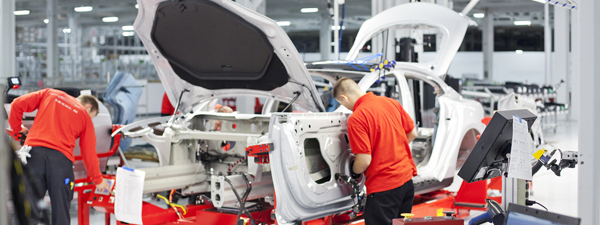Automakers are devoting a lot of effort to making cars lighter these days, and the quest is especially critical for builders of electric vehicles, as less weight can translate into more range…or lower cost. A German research institute called FKA has done a new study, at the behest of a pair of aluminum trade groups, and has found that an aluminum EV (like Tesla’s Model S, pictured above) can cost up to €635 ($829) less than a steel counterpart, despite the higher cost of aluminum, given equivalent range. According to the study, the higher cost of building a car with aluminum is more than offset by the cost savings on the battery pack, as a lighter car needs less battery capacity to drive the same distance.
The FKA team converted a VW Golf with a steel unibody into an EV, then replaced the steel with an aluminum frame. The aluminum vehicle was required to meet the same crash standards as the steel vehicle. They were able to reduce the weight of the body by 162 kg (357 lbs) compared to the steel reference vehicle. The battery system capacity could now be reduced by 3.3 kWh while maintaining a driving range of 200 km (124 miles). The smaller battery is 25 kg (55 lbs) lighter (the team made some assumptions about battery technology projected to be available in 2015), making the aluminum EV a total of 187 kg (412 lbs) lighter than the steel vehicle.
FKA calculated that, at a production volume of 100,000 vehicles per year, the aluminum vehicle would cost €1,015 ($1,324) more than the steel. Assuming battery system costs of €500/kWh ($652/kWh), the reduction in total battery system costs is €1,650 ($2,152).
If we compare the additional costs of the lightweight design with the reduction in battery system costs, it can be concluded that the benefits obtained from lower battery costs more than outweigh the additional costs for the lightweight aluminum vehicle. With the assumptions made in this report, the total cost of the aluminum electric vehicle is €635 ($829) lower than for the steel electric vehicle.
– “Investigation of the Trade-off Between Lightweight and Battery Cost for an Aluminum-intensive Electric Vehicle”
A life-cycle analysis found that the aluminum EV would emit 1.5 tons less greenhouse gases over its complete factory-to-junkyard life cycle, including production, a driving distance of 150,000 km, and recycling.
Source: Green Car Congress


















































